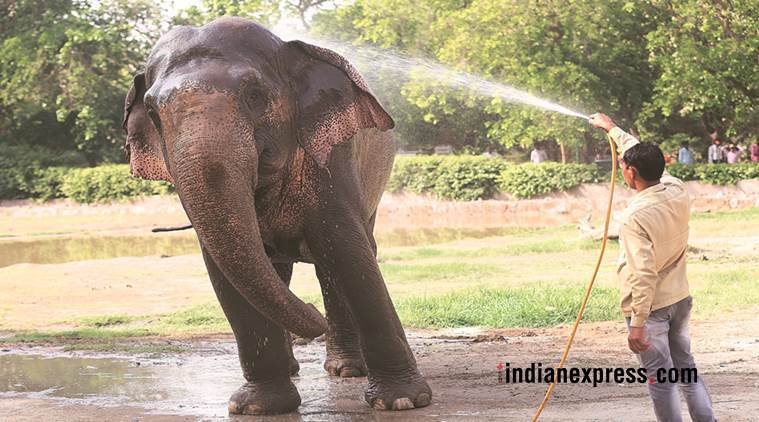Stay updated with the latest - Click here to follow us on Instagram
Mud baths, showers, fruits to keep Delhi Zoo occupants cool
“The three elephants (two Indian and one African) are due to get a new shower,” said Renu Singh, director of the Delhi Zoo. “It should be ready in the next two-three days.”
 Zoo officials have installed 36 coolers, more than 100 fans, and agro-nets to help animals deal with the summer. (Express Photo by Amit Mehra/Files)
Zoo officials have installed 36 coolers, more than 100 fans, and agro-nets to help animals deal with the summer. (Express Photo by Amit Mehra/Files)
While tuskers Raj Laxmi, Heera, and Shankar are oblivious to the developments in their enclosure, they are in for a big surprise — a brand-new shower to bathe under. As temperatures soar in the capital, the Delhi Zoo is leaving no stone unturned to protect the animals. “The three elephants (two Indian and one African) are due to get a new shower,” said Renu Singh, director of the Delhi Zoo. “It should be ready in the next two-three days.”
On a hot Monday afternoon, as visitors watched spotted deer, goral, peacocks, and rhinos laze under the shade of the trees, the management sprinkled water to keep them cool. “When temperatures cross 30 degree Celsius, we start removing all the winter arrangements. We have installed 36 coolers, more than 100 fans, and agro-nets to help the animals deal with the summer,” said Singh.
Ponds inside the enclosure of the Himalayan Black Bears, tigers, hippos and rhinos are filled with more water; fiber-sheets are removed from the enclosures of reptiles; and mud baths are prepared for megaherbivores such as elephants, zoo officials said.
“Elephants don’t have sweat glands so they roll around in mud and require a lot of water… this way they don’t get dehydrated. They are clever animals… they broke the pipe of a shower that was installed while playing with it. So this time, we have to do it in a more clandestine manner,” said Dr Abhijit Bhawal, veterinary officer of the Delhi Zoo.
For the pelicans and macaws, sprinklers have been arranged. Last year, when the heat wave struck Delhi, ice was used for the Himalayan Black Bear — one of which had been brought from Gopalpur Zoo near Shimla. “They need continuous water flow and coolers inside their enclosures, so they can acclimatise to the weather in Delhi,” said Bhawal.
Zoo officials added that meat quantity for the bigger animals has come down from 12 kg to 10 kg; while the five Black Bears are being fed kheer (milk and rice) instead of the winter staple of bread and milk.
“These species are not tropical in nature, so they need more cooling — unlike deer and black bucks that are accustomed to the heat. Apart from such arrangements, we also shift to a summer diet of melons, watermelons and cucumbers,” said Bhawal.







